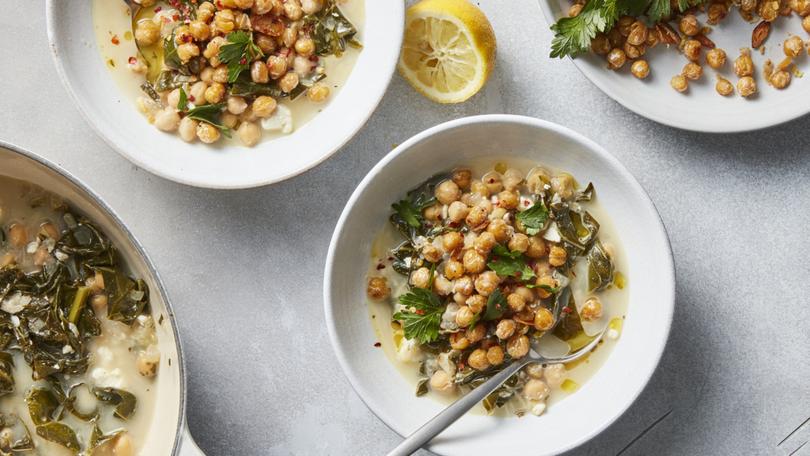The New York Times: The secret to eating healthy all week

It’s one of those long days, and your stomach growls as you scan your fridge. It seems overwhelming and a little stressful to cook, especially on the fly. So you order in. Again.
My job as a columnist at New York Times Cooking is to help ease your way into regularly making stress-free dinners. The payoff is big, because cooking from scratch is always more economical and healthier than takeout — and it can be almost as easy. You don’t need loads of time, fancy ingredients or a sous chef, just a little advance planning. Spending a couple of hours over the weekend to prep a few foundational elements is your key to breezy weeknight meals.
Wash and cut any vegetables for the coming week.
Sign up to The Nightly's newsletters.
Get the first look at the digital newspaper, curated daily stories and breaking headlines delivered to your inbox.
By continuing you agree to our Terms and Privacy Policy.As soon as I get home on Saturday mornings with my farmers market haul, I prep the piles of greens and produce.
Wherever you do your shopping, the drill is the same: Wash all the salad and other greens (spinach, kale, chard, etc.), spin dry, roll them into clean dish towels and store them (with the towel) in plastic or produce bags in the fridge.
They’ll last at least a week, so you can turn them into salads with dressings you have on hand. The hardy greens can go into a skillet with garlic, ginger and chile for a quick cook, adding cut up chicken or tofu to make a stir-fry. Simply season to taste with soy sauce and sesame oil.
For simple cooking, wash, cut and store any sturdy vegetables (asparagus, carrots, squash, zucchini, broccoli, cauliflower, mushrooms, radishes, turnips). Even alliums like scallions, leeks and onions will last in the fridge, sliced or diced, for three or four days. Just avoid pre-chopping avocados, potatoes, eggplant or tomatoes; they don’t hold up as well.
Stock up on cooked rice.
Whether you use a rice cooker or a pot on the stove, keeping white or brown rice in the fridge is the secret to speedy meals (tuna mayo rice bowl, anyone?). Rice that’s a few days old works even better in stir-fries than fresh cooked, getting nice and crisp.
Prepare a pot of beans.
Beans cooked from scratch are less expensive and often taste a lot better than canned, especially when seasoned with garlic, avocado or bay leaves and herbs, as in frijoles de olla. Then savour them with the rice you also made.
Have a library of sauces at hand.
Heed the advice of my colleague Tanya Sichynsky, who writes a newsletter for vegetarian cooking, and assemble a sauce library (to which I’d add an annex for dressings and easy marinades). Then, borrow from it all week long to use on your rice, beans, salads and other easy meals.
For one-minute salads, make a blistered tomato dressing.
Even if you just try one or two of these strategies over the weekend, I guarantee your whole week will go better, or at least, a lot more flavorfully.
—Recipe: Frijoles de Olla (Homestyle Black Beans)
By Rick A. Martínez
This beloved dish often starts with unsoaked dried beans, which are traditionally cooked in an olla, earthenware pot, or other types of clay pots, such as a cazuela de barro. Any pot works, and the seasonings are generally simple — usually onion, garlic, herbs and sometimes lard or pork — but the resulting flavor is rich and complex. A staple throughout Mexico, this dish varies from region to region in the types of beans used and include pinto beans, black beans and Mayocoba beans. Eaten as is as a side or a main dish, frijoles de olla also can be puréed, smashed or refried and used as a sauce or a filling for dishes like tetelas.
Yield: 3 quarts
Total time: 2 hours 35 minutes
Ingredients:
- 1 pound/453 grams dried black beans, rinsed and picked through
- 1/4 medium white onion, chopped
- 3 garlic cloves, finely chopped
- 2 dried or fresh avocado or bay leaves
- 3 fresh epazote sprigs or a combination of parsley, oregano and mint sprigs
Fine sea salt
Preparation:
1. In a large pot, combine the beans, onion, garlic, avocado leaves, epazote, 4 teaspoons salt and 16 cups of water. Bring to a boil over high. Reduce the heat to medium-low and cook at a slow simmer, uncovered, skimming and stirring occasionally, until the beans are tender, 1 1/2 to 3 1/2 hours. Check the beans every hour to see if they need more water; the beans should always be covered by water. The cooking time will depend on how old the beans are; freshly dried beans can fully cook in 1 1/2 hours.
2. Remove and discard the herbs. Taste and season the beans with more salt if desired. The beans and their cooking liquid can be refrigerated for up to 2 days. Or, make them up to 3 months ahead and freeze in an airtight container.
Recipe: Tuna Mayo Rice Bowl
By Eric Kim
This homey dish takes comforting canned tuna to richer, silkier heights. Mayonnaise helps to hold the tuna together, and toasted sesame oil lends incomparable nuttiness. You can adjust the seasonings to your taste: Use as much or as little soy sauce as you’d like for a savory accent. You can lean into the nuttiness of this rice bowl by sowing the top with toasted sesame seeds, or amp up the savoriness with furikake or scallions. A staple of home cooking in Hawaii and South Korea (where it is sometimes called deopbap), this simple meal is a workday workhorse.
Yield: 1 serving
Total time: 5 minutes
Ingredients:
- 1 (5-ounce) can tuna (preferably any variety stored in oil), well drained
- 2 tablespoons mayonnaise
- 1 teaspoon toasted sesame oil
- 1/2 teaspoon soy sauce
- 1 cup cooked white rice (preferably short- or medium-grain)
- Toasted white or black sesame seeds, furikake or chopped scallions, for topping (optional)
Preparation:
1. In a small bowl, stir the tuna, mayonnaise, sesame oil and soy sauce to combine.
2. Add the white rice to a bowl and spoon the tuna mixture on top. Sprinkle with the sesame seeds, furikake or scallions, if using.
Recipe: Blistered Tomato Dressing
By Yewande Komolafe
A vinaigrette can be as simple as an emulsion of oil and vinegar, but a memorable one carries flavors that hint at the season. This one, featuring charred tomatoes, is perfect for summer. Blistering fresh tomatoes deepens their acidic sweetness. Made with sherry vinegar and olive oil, the dressing is at once earthy and bright.
Yield: About 2 cups
Total time: 20 minutes
Ingredients:
- 1 pound tomatoes (about 3 medium) or 2 pints cherry tomatoes
- 1 shallot, peeled and minced
- 2 tablespoons sherry vinegar, plus more to taste
- 1/2 teaspoon red-pepper flakes (optional)
- 1/2 teaspoon kosher salt (Diamond Crystal), plus more to taste
- 1/4 teaspoon black pepper
- 1/4 cup extra-virgin olive oil
Preparation:
1. Heat a broiler to high. Place the tomatoes on a sheet pan and broil until the skin is charred and peeling, about 6 minutes. Flip and char the other sides until the tomatoes are soft and begin to release some of their moisture, about 5 minutes. If using cherry tomatoes, blister without turning until the tomatoes char, collapse and release their moisture, about 10 minutes.
2. When the whole tomatoes are cool enough to handle, transfer them to a board and coarsely chop. (Skip this step if you used cherry tomatoes.) Transfer the tomatoes with their juices to a medium bowl. Add the shallot, sherry vinegar, red-pepper flakes, if using, and the salt and pepper. Stir in the olive oil. Taste and add more vinegar and salt if necessary.
3. Use immediately or refrigerate in an airtight container for up to 2 days. Serve as a dressing over cooked leafy greens, green salads, grain salads, roasted or grilled vegetables, meat and fish.
This article originally appeared in The New York Times.
© 2024 The New York Times Company
Originally published on The New York Times
